|
A6M2 Type 21 Zero
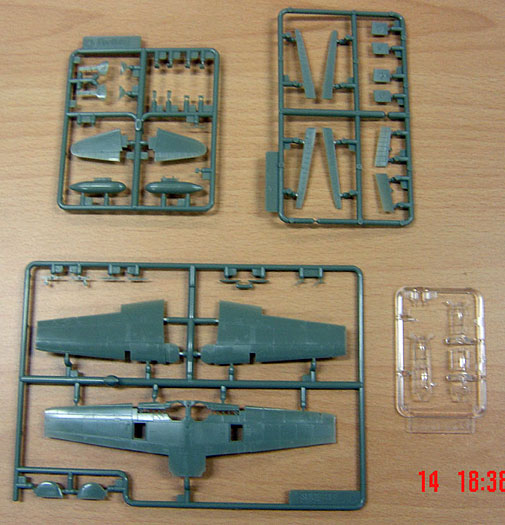
Fine Molds, 1/72 scale
S
u m m a r y
|
| Catalogue Number: |
Fine Molds A6M2 Type 21 Zero
(catalogue number not quoted) |
| Scale: |
1/72 |
| Contents and Media: |
See text and images below |
| Price: |
2600 Yen from Hobbylink Japan |
| Review Type: |
FirstLook |
| Advantages: |
High quality injection plastic
mouldings;
superb level of detail; excellent quality clear parts including options
for open and closed canopy; |
| Disadvantages: |
Slightly confusing instructions;
limited availability |
| Recommendation: |
Highly Recommended |
Reviewed by Jega M

HyperScale is proudly supported by Squadron.com
The "Ultimate Zero"
I have just gotten my paws on the new 1/72 scale
Fine Molds A6M2 Type 21 Zero Fighter.
Fine Molds and Model Graphix Magazine have teamed up to offer this new
kit, including it as a two-part special in the November and December
issues of Model Graphix. The November issue includes the fuselage and
cockpit parts, with the December issue containing the wings and other
details. The instructions for each phase of assembly are included in
their respective issues.
I ordered mine through HLJ (HobbyLink Japan). According to the HLJ
website, this particular Zero kit from Fine Molds will only be offered
as a premium included with the two issues of Model Graphix and will not
be sold as a separate kit.
You can order the magazines as separate issues (with their respective
halves of the kit) or as HLJís special offering of both issues that
includes the entire kit.
Packaging
The kit parts come in sturdy brown boxes with
line drawings of the Zero on the front. November parts are shown in the
large photo below:
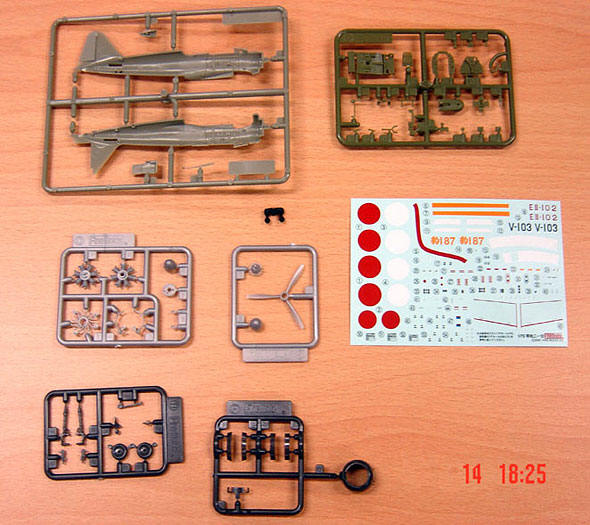
Click
the thumbnails below to view larger images:
[../../../photogallery/photo00012487/real.htm]
The Kit
This new Fine Molds kit is
undoubtedly the finest Zero kit in 1/72 scale. The current leader in
1/72 is Hasegawa. As opposed to their older, raised panel-lined, raised
rivets, bathtub-for-a-cockpit, 1/72 Zeros, Hasegawaís newer tooled ones
have nicely recessed panel lines, nice engines, a well detailed cockpit
and are of a modular design. The cockpits have decals for the instrument
panel. The canopies are all one piece, so you cannot view any work done
in the interior through the kitís canopy.
The Fine Molds kit blows away the Hasegawa.
The details are exquisite and authentic all over. Flaps and ailerons are
molded separately, as are the cowl flaps. This means that you have a
choice of open or closed cowling flaps. Is that cool or what?
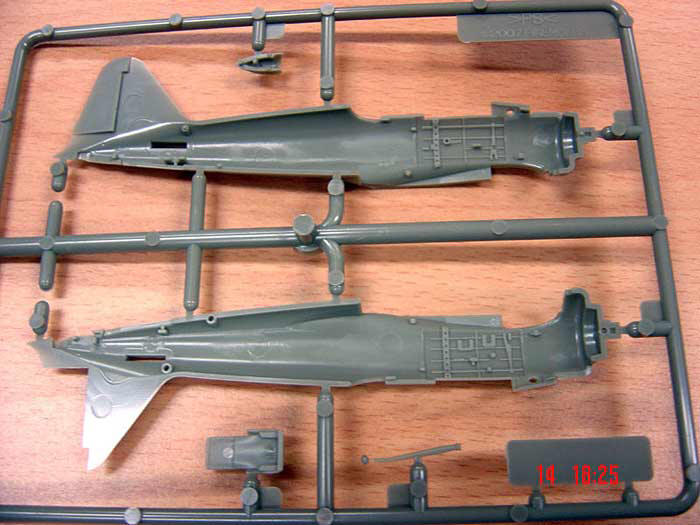
Click
the thumbnails below to view larger images:
[../../../photogallery/photo00028491/real.htm]
The canopy looks very clear and can
be built as either in a one-piece closed position or as a three-piece
assembly in the open position. My personal opinion is that most of you
would want to build the canopy in the open position because of the
fantabulous detail of the cockpit! And no, the instruction panel does
not consist of just a one-piece decal. The various dials & instruments
are given as sharply printed decals but the panel itself has recessed
holes for the dials to give them a realistic look.
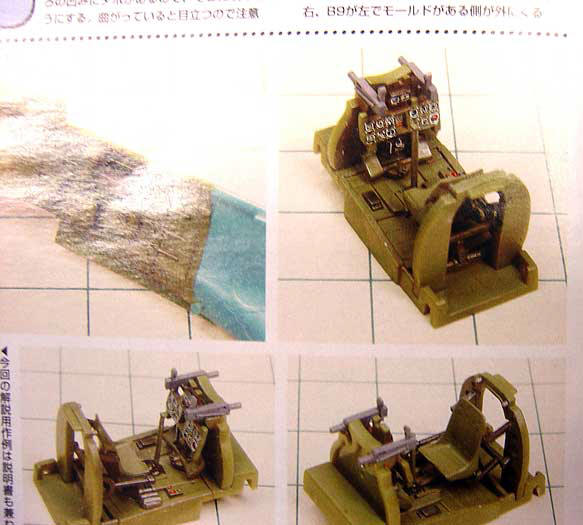
THE BEAUTIFUL COCKPIT (Yes,
that IS 1/72 scale!)
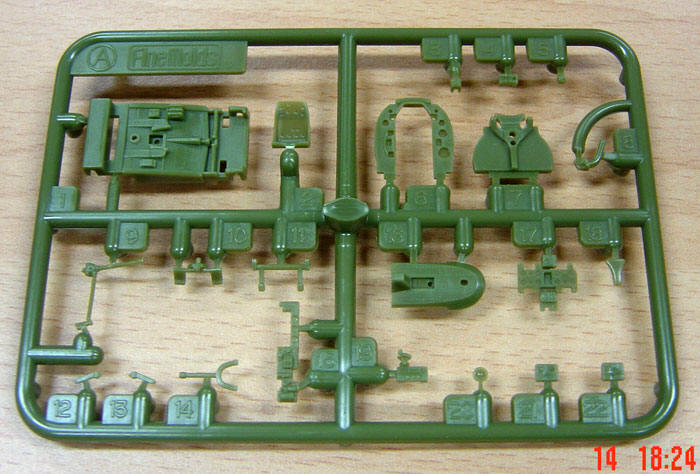
COCKPIT/INTERIOR PARTS
The engine and landing gear feature
fantastic details, and the kit includes optional parts for the
propeller's spinner, wing gun ports, and underwing gun access panels.
Wings
Note the separate wing tips on the
bottom left. The wings can be assembled with them folded.
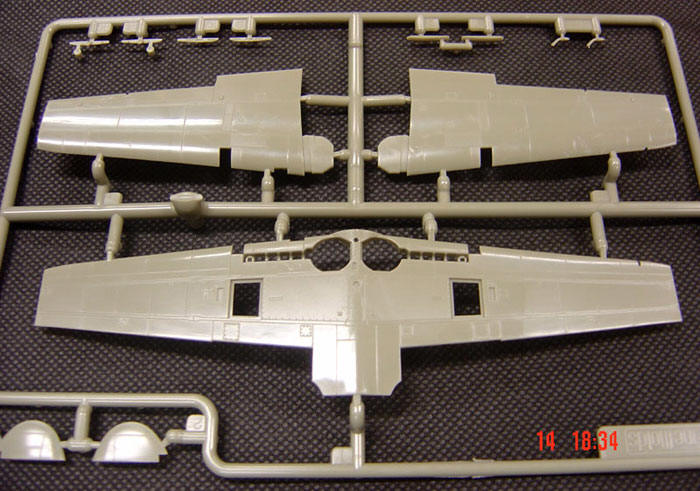
Thumbs up for the attention to detail. I guess Fine Molds really IS fine
molds.
Decals & Paint Schemes
The decals appear thin, sharp and
very nicely printed.
Markings are included for three versions: legendary Zero ace Saburo
Sakai's V-103 aircraft, Tetsuzo Iwamoto's EII-I02 aircraft based on the
IJN aircraft carrier Zuikaku, and an aircraft from the 263rd Squadron.
Sakai-sanís and Iwamoto-sanís aircraft are in the overall light grey
scheme. You may want to note that, in view of new research, the 'light
grey' will actually have to be painted in ame-iro, a caramel-ish sort of
colour.
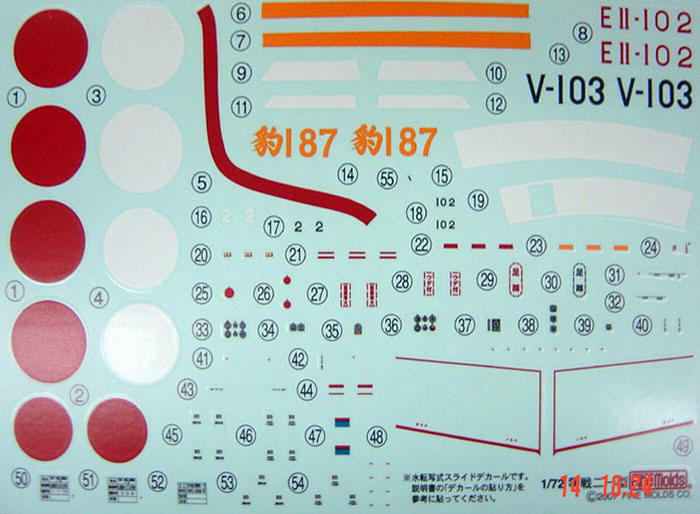
The third option, the 263rd Squadron machine, is in the IJN green over
light green scheme. Yes, IJN green over light green not grey. At least,
thatís what appears to me when I look at the painting instructions.
Although, when I think about it, it could be Grey-green (like Tamiya
AS-29 Spray-can) I could be wrong but you will soon find out why. As for
the actual paint numbers, there is a slight problem with interpreting
them. More on this below.
The Magazine
Model Graphix is touted as Japan's
most well-rounded hobby magazine, containing articles on all modeling
genres including aircraft, figures, science fiction, cars, ships, and
more. Very good photographs, both black & white as well as in colour.
Unfortunately for the English-speaking only, almost all text is in
Japanese.
This creates a little bit of a problem when you want to build the Fine
Molds Zero as all the construction & painting instructions are in the
Japanese-text magazine and not on separate sheets as is the norm in
model kits.
This language barrier however, is lessened somewhat because of the
numerous construction pics in the magazine. The instructions for
building the Zero are given as rows of step-by-step pics, with the
respective instructions (in Japanese) captioned below each picture.
Assembly Instructions
They say a picture is worth a
thousand words and so it is with the instructions in the magazine. The
problem I foresee is that their books/magazines start from the last
page. At least thatĎs what it appears to be for those who arenít used to
the Japanese way of doing things. You see, in most of the
English-speaking world, we read our magazines & books starting from the
right & flipping the page over to the left. Japanese reading materials
however, start from the left and flip the page over to the right. So,
from a non-Japanese personís point of view, the first page of the Model
Graphix magazine actually starts from the last page of the magazine.
And while we read a text from left-to-right, the Japanese read them from
right-to-left (please forgive me if Iím wrong on this). This is why the
step-by-step construction instructions for the Fine Molds Zero appear to
be backwards (ie, starts from the right and goes to the left). This
needs some getting used to, particularly when you go from one row of
construction pics to the next. When most of us scan a page, our eyes
move from left to right & then move to the next line to start from the
left again. The Model Graphix magazine, however, shows the step-by-step
pics from right-to-left and then your eyes are forced to move to the
right of the next row and then follow the sequence of construction pics.
This can be a little confusing at times and the problem is compounded by
the fact that the pics are NOT NUMBERED. There are ďarrowsĒ that point
to the next step but this isnít always the case. So, frequently, youíre
left with your own deduction on what the next step should be. And it
doesnít help if you canít read the language.
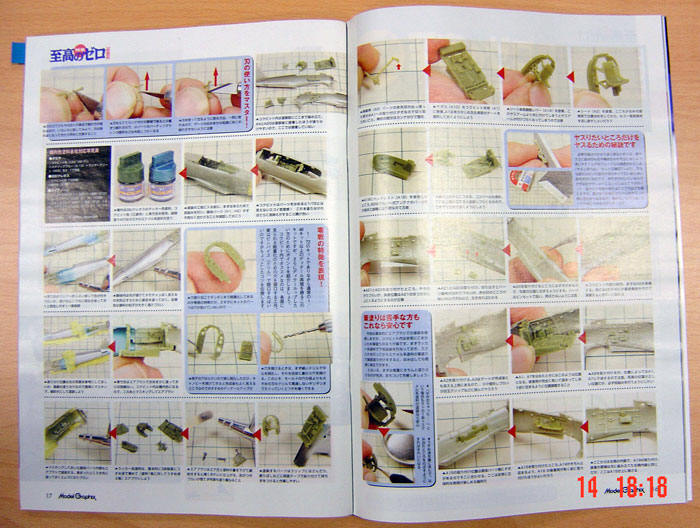
There are, thankfully, numbered drawings (as opposed to the numberless
pics) that tell you what to do next. Again, however, the instructions
for these drawings are in Japanese.
At this point, you may begin to understand my confusion about the paint
scheme as stated earlier. The paint scheme numbers are not clearly
stated and itís up to the modeler to track down what each number stands
for and which part of the plane itís supposed to go on.
(I gotta find me a model-building Japanese girlfriend and have her read
the instructions to me.)
Anyway, while the step-by-step pics & construction drawings take a while
to follow, it would have helped greatly if Model Graphix had followed
their Aero Detail series of books which contain both Japanese as well as
complete English texts for their captions.
This is, without a doubt, the best
Zero out there in 1/72 scale. In fact, the Model Graphix magazine calls
it the ďUltimate ZeroĒ. It says so in the magazine as well as on the
kitís boxing. It may not be for the average modeler or for those looking
for a quick build but if you only build one Zero in your entire modeling
life (yeah, right *snigger*) this should be it. Fine Molds/Model
Graphixís offering of the Type 21 Zero is one fantastic looking model,
with recherchť and jaw-dropping detail for this scale.
In fact, if I was an Orang Utan, I would give it FOUR thumbs-up. LOL!
Iím picturing mine in a diorama of a carrier-based A6M2 on an IJN
carrier deck with the wings folded and undergoing maintenance. Canít let
those open gun-bays & engine detail go to waste, right?
Sample purchased by reviewer
Review Text and Images Copyright © 2007 by Jega M
Page Created 21 November, 2007
Last updated 24 December, 2007
Back to HyperScale Main Page
Back to Reviews Page
|
Home
| What's New |
Features |
Gallery |
Reviews |
Reference |
Forum |